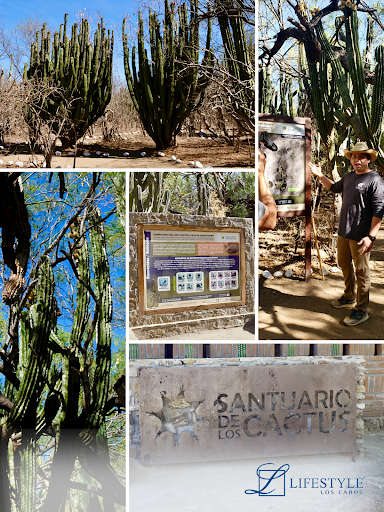The Giants of The Desert
Natural Reserve
Baja California Sur

Located 11 km from El Triunfo and 149 km from Cabo San Lucas, this small ecological reserve can be reached by a dirt road that connects to Route 1. It is a place where visitors can walk along paths delimited for observing the local fauna and flora. The giant cacti and biznagas are the main attractions, and a friendly person is always available to provide information, even though there is no permanent guide.
Dr. Héctor Nolasco Soria (CIBNOR) started the Cactus Sanctuary on June 5, 1997, with the aim of valuing the presence of the cacti that are so common on the peninsula. On this ecotourism tour, visitors can see species such as the barbon cardón, pelon cardón, garambullo, sweet and sour pitaya, choya, and nopal. The place’s grand attraction is the cardones and mesquites, that are over 500 years old.
The Sanctuary is not only visited by national and foreign tourists but also by researchers and scientists from the Northwest Biological Research Center (CIBNOR), who work to protect and conserve the local flora and fauna.
Visitors can also observe hawks, iguanas, turtles, coyotes, and various birds during the tour, making it an excellent opportunity to enrich their knowledge and environmental awareness.
Cactus Curiosities:
- Cacti originated more than 30 million years ago in the Oligocene epoch. They are native to America, although some species are native to Africa, Madagascar, and Ceylon.
- Depending on the species and environmental conditions, cacti can live more than 250 years, with the longest-lived becoming centenarians.
- Cacti have spines to protect themselves from animals that want to bite them and drink the water inside. They also have many thin, white thorns to protect themselves from the sun, maintain their temperature, and avoid dehydration.
- Cacti can survive up to two years without water. They grow in environments with extreme weather conditions, drought, and heavy rain and are adapted to these conditions, making them one of the most incredible species of flora on earth.
- The name of the cactus family is Cactaceae, divided into about 170 genera and more than 2,500 species.
- Cacti can become giant; the largest can weigh 12,000 kg and measure 16 meters high. They can absorb more than 1,000 liters of water in 48 hours.
- Contrary to popular belief, cacti roots extend horizontally for hundreds of meters, creating a stable base for them to stay upright.
Visiting spaces that enrich us in knowledge and environmental awareness is one of the options that LIFESTYLE wants to offer our guests. Getting to know our region in all its forms will make them even fall in love with this paradise.
Due to their great importance, these protected areas are governed by specific protection, restoration, and conservation guidelines since they are vital in maintaining spaces that safeguard biodiversity.
LIFESTYLE wants to bring you closer to knowing these natural wonders to create together a community that promotes revalues. We are multiplier agents creating greater awareness in pursuit of the benefits of visiting these places; we educate ourselves about the beneficial functions that natural areas have, like El Santuario de los Cactus, and we consume locally.
Tourism done conscientiously is one of the activities that brings the most benefits to visitors and destinations that deserve special and respectful care.
